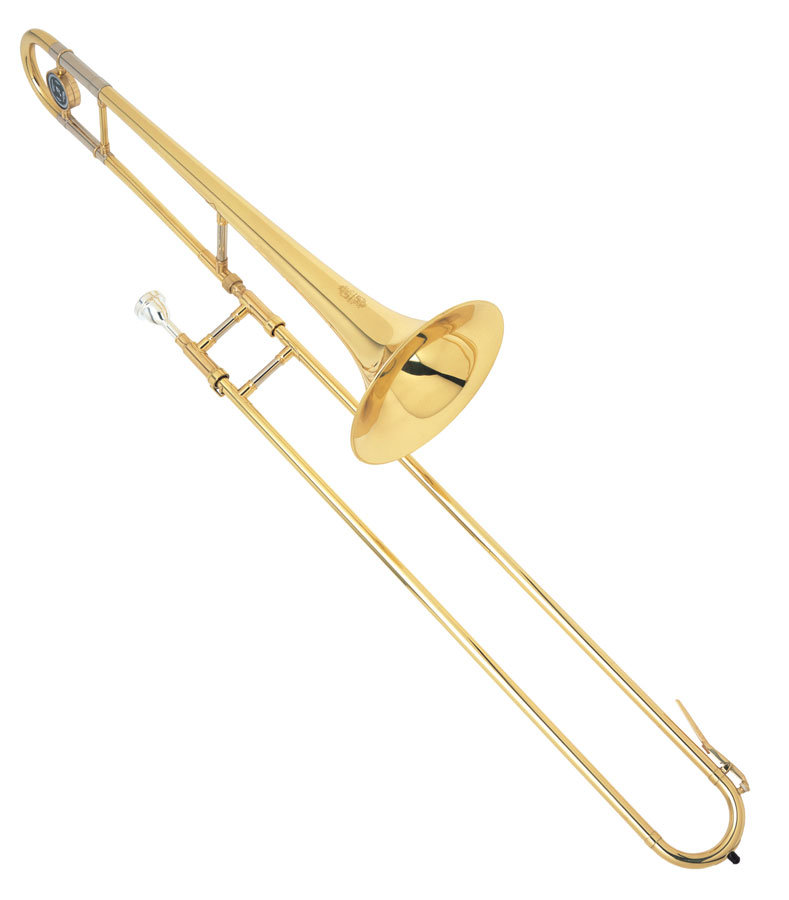
Image source: https://c1.zzounds.com/media/fit,2018by3200/quality,85/trombone-0b7d11e55e483c6d0d54d9ca28177501.jpg
(For the examples in this article, pitches are defined as middle C = C4.)
Do You Have to Transpose Music For a B-Flat Trombone? How Do Different Instruments Transpose?
So, What Is a B-Flat Tenor Trombone?
Most trombones are called "B-flat trombones" because they are built to play a B-flat when in first position. In other words, the fundamental of the horn is a B-flat.
Now, when a B-flat trumpet plays a note in open position (no valves pushed down), the note produced is also a B-flat. So B-flat trombones and B-flat trumpets read the same music right? Well, the answer is NO.
The B-flat trumpet reads music that is transposed to a different key and the trombone reads music that is NOT transposed.
Go To the Piano For the Answer
Think of it this way: A trombone player can read the bass clef of piano music and it will sound exactly the same as what the piano plays. All the notes sound the same. A piano player playing an "F" will sound the same note as a trombone player playing the same "F." The piano is what we call a non-transposing instrument, or in the key of "C."
A B-flat trombone and piano playing the note "F" will sound the same note: Example: F3
Here It Gets Tricky
Now, for the B-flat trumpet player, when they play an "F" an octave higher, and the piano player plays the same "F," what happens? The two notes will sound different! That is because music must be transposed for the B-flat trumpet to sound the same as other instruments that are in the key of C. B-flat trumpet music must be transposed UP A MAJOR SECOND to play along with instruments in the key of C.
A B-flat trumpet and piano playing this "F" will sound different notes! Example: F4
To sound the same note, the following pitches must be played: Piano Example: F4 B-flat trumpet Example: G4
Because B-flat trumpet music must be transposed UP A MAJOR SECOND to play the correct concert (key of C) pitches, it is therefore named "B-flat" trumpet, because the tones coming out are in the key of B-flat and not C.
The general rule for transposing instruments is to think of getting them to the key of C. For example, an instrument in the key of B-flat must be transposed UP A MAJOR SECOND to get to the key of C. (B-flat to C is a major second interval).
Here are other examples of how to transpose for various instruments:
D trumpet: transpose DOWN A MAJOR SECOND (to get to C)
E-flat trumpet: transpose DOWN A MINOR THIRD (to get to C)
E trumpet: transpose DOWN A MAJOR THIRD (to get to C)
C trumpet: no transposition needed (already in C)
B-flat trumpet: transpose UP A MAJOR SECOND (to get to C)
C Flute no transposition needed (already in C)
D-flat Piccolo transpose DOWN A MINOR SECOND (to get to C)
E-flat Alto Sax transpose UP A MAJOR SIXTH (to get to C)
F French Horn transpose UP A PERFECT FIFTH (to get to C)
G Flute (Alto Flute) transpose UP A PERFECT FOURTH (to get to C)
What Does That Have To Do With the B-Flat Trombone?
As you see above, music for the B-flat trumpet must be transposed to play with instruments in C. So, you might think that music for the B-flat tenor trombone must also transposedNO!
It's just the way the name has developed, that the B-flat tenor trombone does NOT need to have music transposed, even though the name might suggest it.
The "B-flat" in the name is really just a designation as to the key in which the trombone is built (the fundamental tone).
So, Why Not Call It a "C Trombone?"
That seems to make sense, but as time has a habit of solidifying names and this is the name we are left withB-flat tenor trombone. To add more confusion, there ARE some rare trombones made in C and these as you might guess, are built in the key of C. C is the fundamental note, then note played in first position. Again, these are RARE.
The Moral of the Story:
The B-flat tenor trombone is built in the key of B-flat and thus given its name. It is a non-transposing instrument along with other instruments in the key of Cthe C flute, oboe, bassoon, violin, for example. Don't confuse the B-flat trombone (non-transposing) with the B-flat instruments that ARE transposed, like the B-flat Clarinet, B-flat Trumpet, and B-flat Tenor Sax, for example.